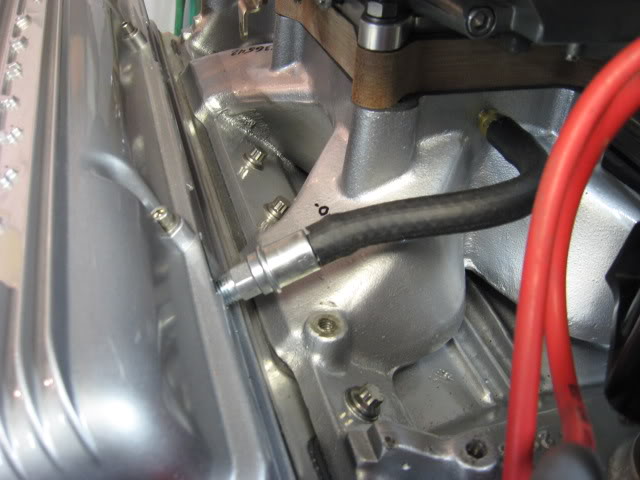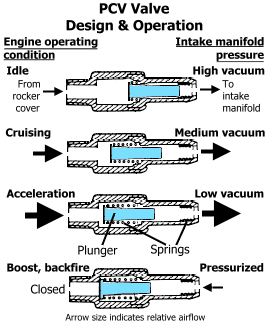New Intake, Non-vented Valve Covers. Best venting options
#21
Team Owner


Most breather caps just have some coiled up metal foil which acts as a very coarse filter.That cap is the vent for the engine. And, I'm sure, it also acts as the exhaust 'dump' when the crankcase has positive pressure. Besides, the PCV valve is horizontal...rather than vertical...so gravity can't keep the valve sealed until it has elevated pressure. Your PCV valve is 'sequenced' properly...it's just not oriented so that it will function as intended.
#22
#23
Tech Contributor
Member Since: Aug 1999
Location: At my Bar drinking and wrenching in Lafayette Colorado
Posts: 13,656
Received 4,927 Likes
on
1,932 Posts

GM installed these screw-in PCVs horizontally into the oil fill tubes on all 66-67 327 engines, including Corvettes. They work fine.
Lars

Lars
#24
Team Owner


Always willing to learn from the master, Lars. With no spring in the system and very low pressures to deal with, how does that valve 'know' when to seal and when to open? Looks to me like accel and decel forces will decide which way it moves. 

#25
Tech Contributor
Member Since: Aug 1999
Location: At my Bar drinking and wrenching in Lafayette Colorado
Posts: 13,656
Received 4,927 Likes
on
1,932 Posts

The only logical conclusion is that GM built 1.2 million cars over a 2-year period with non-functional PCV valves. They probably never tested the PCV systems with the horizontal valves to see if they worked before putting the systems into production for 2 years...
But seriously, if you look at the GM horizontally-mounted PCVs and the one I have in my valve cover spacer, you will note that the valves are not completely horizontal: They have enough of an angle that the weighted valve gets enough gravity assist to do its thing. The screw-in valves were designed for this mild angle install, and perform as intended in this position. Wondering about this myself when designing my system, I actually did a "suck test" on the valve to assure that it lifted, seated, and acted as intended with the mild installed angle. It does. But it does make you wonder about the PCVs that GM installed in a true horizontal position: The were several 2GV and AFB carb applications where the PCV screwed directly into the back of the carb's throttle plate in a "0" horizontal position. These, too, work as intended.
But seriously, if you look at the GM horizontally-mounted PCVs and the one I have in my valve cover spacer, you will note that the valves are not completely horizontal: They have enough of an angle that the weighted valve gets enough gravity assist to do its thing. The screw-in valves were designed for this mild angle install, and perform as intended in this position. Wondering about this myself when designing my system, I actually did a "suck test" on the valve to assure that it lifted, seated, and acted as intended with the mild installed angle. It does. But it does make you wonder about the PCVs that GM installed in a true horizontal position: The were several 2GV and AFB carb applications where the PCV screwed directly into the back of the carb's throttle plate in a "0" horizontal position. These, too, work as intended.
#26
Team Owner


Interesting. Their approach was strictly the 1970's/1980's approach to design something that looked good; market it as something that everyone "needed"; and build it as inexpensively as possible while maintaining an adequate level of quality and documentable adherence to the minimum level of U.S. Government requirements. It worked for a while, anyway....long enough for us to get a retirement {even if they are eliminating what we worked 40 years for...a bit at a time}.
Times change....
P.S. Thanks for the 'lesson'...
Times change....
P.S. Thanks for the 'lesson'...
#27
Race Director


I've only ever taken one pcv valve apart and that was about 30 or so years ago. It had a spring inside and I'm pretty sure that all the variable flow valves that we are used to using have the spring inside.
The misconception is that to test a valve you shake it and it is good. Well thats not quite right.
The actual flow oriface is inside the valve, not the hole on the engine side that you see. Inside past the shutoff disk is a tapered plunger that positions itself in the oriface according to engine vacuum conditions constantly adjusting itself. The purpose of the spring is to position the plunger so that maximum flow is at the least manifold vacuum (wot)
The pressure in the crank case at wot along with the spring positioned plunger and the almost zero manifold vacuum still allows the vapors to go thru the pcv valve as well as reversed in the intake tube and into the air cleaner.
Different engines have different valves with different spring rates and flow rates.
The only time the valve is sealed is when there is a backfire.
So shaking to test does little, your spring could be drastically fatigued and the flow all wrong. This can really screw up your idle quality. It's really a pretty delicate balance.
GM wasn't the only one that had problems back then, Porsche used a pcv for a few years, then eliminated them and just ran a tube to the air cleaner for a few years and then changed designs.
Both GM and Porsche are still having pcv issues today and have been trying fixed oriface designs as well as other fixes.
The misconception is that to test a valve you shake it and it is good. Well thats not quite right.
The actual flow oriface is inside the valve, not the hole on the engine side that you see. Inside past the shutoff disk is a tapered plunger that positions itself in the oriface according to engine vacuum conditions constantly adjusting itself. The purpose of the spring is to position the plunger so that maximum flow is at the least manifold vacuum (wot)
The pressure in the crank case at wot along with the spring positioned plunger and the almost zero manifold vacuum still allows the vapors to go thru the pcv valve as well as reversed in the intake tube and into the air cleaner.
Different engines have different valves with different spring rates and flow rates.
The only time the valve is sealed is when there is a backfire.
So shaking to test does little, your spring could be drastically fatigued and the flow all wrong. This can really screw up your idle quality. It's really a pretty delicate balance.
GM wasn't the only one that had problems back then, Porsche used a pcv for a few years, then eliminated them and just ran a tube to the air cleaner for a few years and then changed designs.
Both GM and Porsche are still having pcv issues today and have been trying fixed oriface designs as well as other fixes.
#29
Team Owner


Thanks for the info. Never knew there was a spring in them [never took one apart]. It must be a very light spring...maybe just enough to balance the mass of the valve.
#30
For a PCV system to be functional, you need to have an air "inlet" source on one side of the engine (typically the common "breather" or a hose up to the air cleaner from the valve cover) and a PCV pulling air through the engine on the other side of the engine. Under light throttle, the PCV will pull air in through the breather, through the engine, out the PCV, and into the inatke manifold. Under high load conditions when there is no manifold vacuum and high crankcase blowby, the flow reverses through the breather, and the breather allows crankcase pressure to vent out of the crankcase without needing to pass through the restrictive PCV.
I installed early "no-hole" "Corvette Script" valve covers on my '64 with a 496-horse 407 and I wanted a functioning breather system with PCV without cutting holes in the original covers. Since I had to use spacers to clear my somewhat non-stock valvetrain, I installed the breather and PCV into the spacers. Both penetrations have baffles installed on the inside. Results on the dyno show the system working perfectly, with no oil getting sucked or blown out the breather or PCV - crankcase pressures and ventilation are right where they should be. Photos below show details and overview:
Lars
PCV is the screw-in style unit that came on most '64 small blocks - NAPA shows this as '64 Nova:
Attachment 48180428
Breather in the opposite side is K&N, attached to a 90-degree stainless elbow with some heater hose. This also provides oil filler location:
Attachment 48180429
Everything is tucked towards the back of the engine to get it out of sight:
Attachment 48180430
Fuel pressure regulator and PCV system makes things a little crowded in the back, but there's still room for timing adjustment and reasonable access to components:
Attachment 48180431
Rear-mounted "hidden" system gives clean look to engine and the '64 valve covers: Look! No oil filler, breathers or hoses! How does he do it...?
Attachment 48180432
I installed early "no-hole" "Corvette Script" valve covers on my '64 with a 496-horse 407 and I wanted a functioning breather system with PCV without cutting holes in the original covers. Since I had to use spacers to clear my somewhat non-stock valvetrain, I installed the breather and PCV into the spacers. Both penetrations have baffles installed on the inside. Results on the dyno show the system working perfectly, with no oil getting sucked or blown out the breather or PCV - crankcase pressures and ventilation are right where they should be. Photos below show details and overview:
Lars
PCV is the screw-in style unit that came on most '64 small blocks - NAPA shows this as '64 Nova:
Attachment 48180428
Breather in the opposite side is K&N, attached to a 90-degree stainless elbow with some heater hose. This also provides oil filler location:
Attachment 48180429
Everything is tucked towards the back of the engine to get it out of sight:
Attachment 48180430
Fuel pressure regulator and PCV system makes things a little crowded in the back, but there's still room for timing adjustment and reasonable access to components:
Attachment 48180431
Rear-mounted "hidden" system gives clean look to engine and the '64 valve covers: Look! No oil filler, breathers or hoses! How does he do it...?
Attachment 48180432
#31
Le Mans Master


Member Since: Aug 2017
Location: Cool Northern Michigan
Posts: 6,916
Received 2,132 Likes
on
1,637 Posts
Must have figured it out 12 yrs ago.
How about a brand NEW thread?
How about a brand NEW thread?
Last edited by HeadsU.P.; 05-27-2022 at 05:58 PM.










